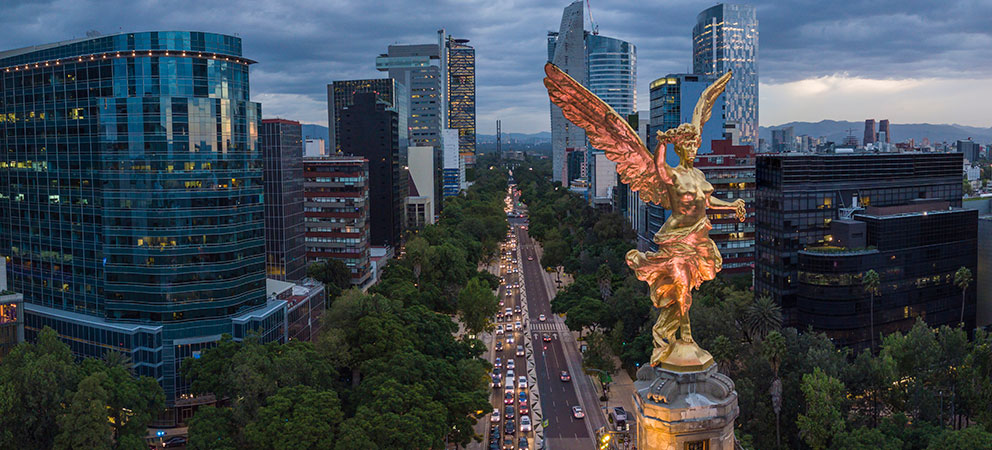
Mexico’s economy slightly improves; outlook deteriorates
October 6, 2022
| September 2022 economic report | |||
| GDP, real April–June '22 |
Employment, formal August '22 |
CPI August '22 |
Peso/dollar September '22 |
| 4.1% q/q | 66,500 jobs m/m | 8.7% y/y | 20.1 |
Mexico’s proxy for monthly GDP averaged 0.2 percent during July and August, a slight improvement over the previous two months. However, the possibility of a U.S. recession, inflationary pressures, weak investment and monetary tightening are headwinds for the Mexican economy. The consensus forecast for 2022 GDP growth (fourth quarter/fourth quarter), compiled by Banco de México, fell in August to 1.8 percent (Table 1).
| Table 1: Consensus forecasts for 2022 Mexico growth, inflation and exchange rate | |||
| July | August | ||
| Real GDP growth (Q4/Q4) |
2.0 |
1.8 |
|
| Real GDP (average year/year) |
1.8 |
1.9 |
|
| CPI (Dec. '22/Dec. '21) |
7.8 |
8.1 |
|
| Exchange rate—pesos/dollar (end of year) |
20.8 |
20.7 |
|
| NOTE: CPI refers to Consumer Price Index. The survey period was Aug. 16–30. The next quarterly GDP data will be available Oct. 30. SOURCE: Encuesta sobre las Expectativas de los Especialistas en Economía del Sector Privado: Agosto de 2022 (communiqué on economic expectations, Banco de México, August 2022). |
|||
The latest data available show growth in industrial production, retail sales, remittances and employment, while exports fell. In August and September, the peso strengthened a bit against the dollar, and inflation remained elevated.
Economic activity improves
The global economic activity index (IGAE)—the monthly proxy for GDP growth—grew 0.2 percent (month over month) on average over July and August, a slight acceleration from the previous two months’ average decline of 0.3 percent (Chart 1). The pickup in activity was mainly due to the goods-producing sector (including manufacturing, construction and utilities), which increased 0.2 percent over July and August. Growth in service-related activities (including trade and transportation) was flat over the same period. On a year-over-year basis, IGAE rose 3.0 percent in August and 2.2 percent in July.
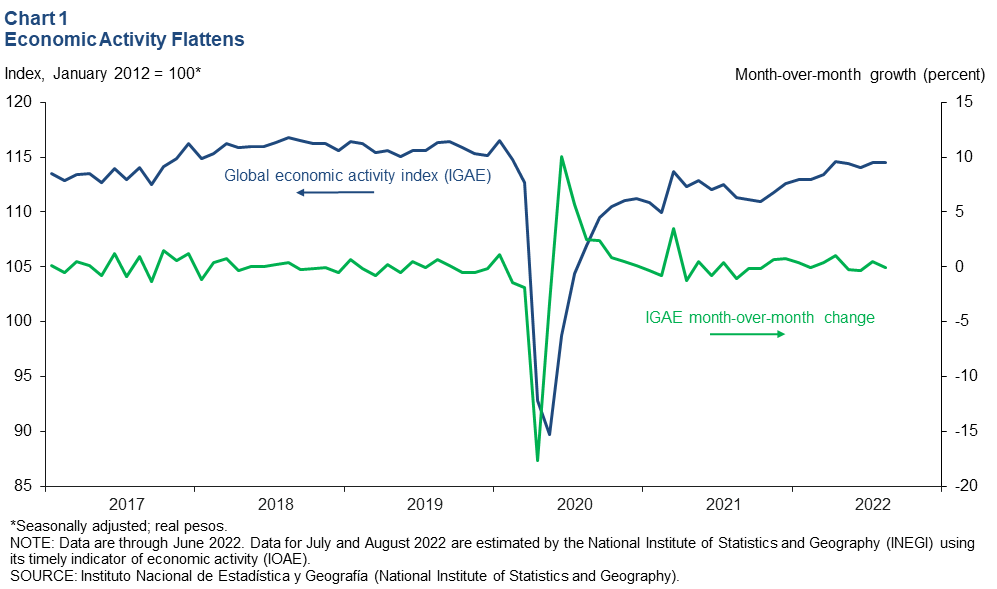
Industrial production ticks up
The three-month moving average of Mexico’s industrial production (IP) index—which includes manufacturing, construction, oil and gas extraction, and utilities—increased 0.2 percent in July from June (Chart 2). On a month-over-month and unsmoothed basis, IP was up 0.4 percent in July while manufacturing IP increased 1.6 percent. North of the border, U.S. IP dipped 0.2 percent in August after rising 0.5 percent in July. The correlation between IP in Mexico and the U.S. has increased considerably with the rise of intra-industry trade between the two countries since the early 1990s. Mexico’s manufacturing sector could experience a slowdown toward the end of the year, particularly if U.S. consumer demand decelerates as a result of high inflation and higher interest rates.
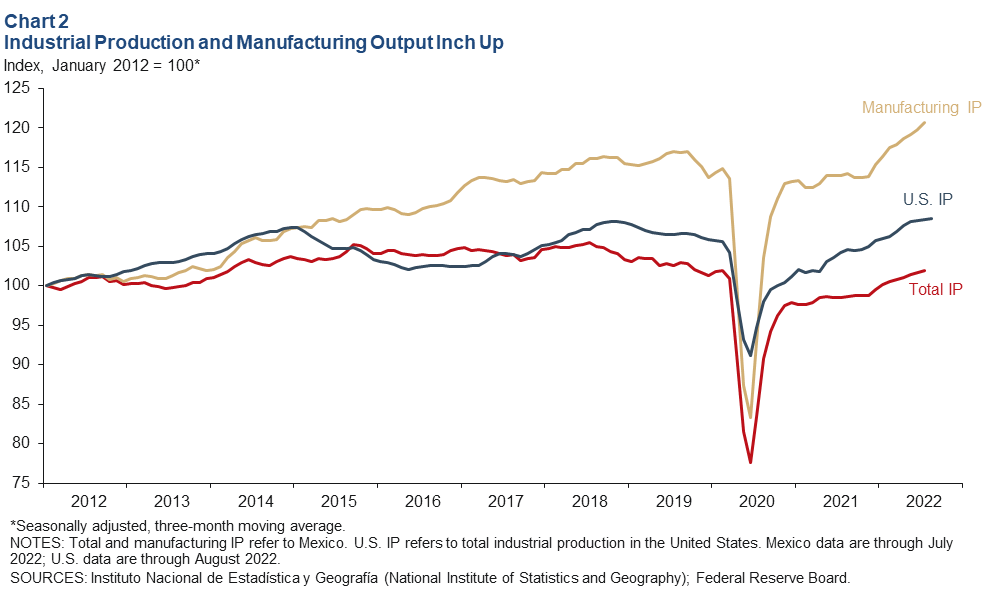
Total exports dip
The three-month moving average of total Mexico exports was down 0.5 percent in August as oil exports fell and the much-larger manufacturing exports category was unchanged due in part to weakening global demand (Chart 3). On a month-over-month and unsmoothed basis, total exports fell 1.0 percent in August, with oil exports falling 14.9 percent and manufacturing exports rising 0.8 percent. The rise in oil prices contributed to growth in oil exports earlier in the year, but oil exports are now declining as prices retreat.
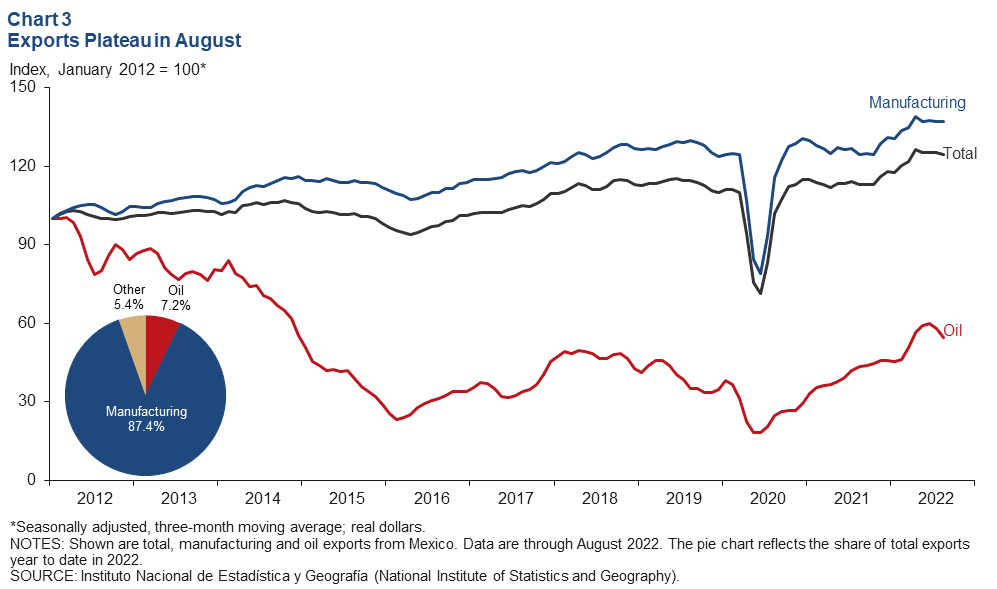
Retail sales continue to climb
The index of real Mexico retail sales increased 0.4 percent month over month, based on a three-month moving average through July (Chart 4). On a month-over-month and unsmoothed basis, retail sales also grew, up 0.9 percent in July. Retail sales reached prepandemic levels (February 2020) in October 2021. Recent strong growth in remittance flows may be contributing to the continued increase in retail sales despite high inflation.
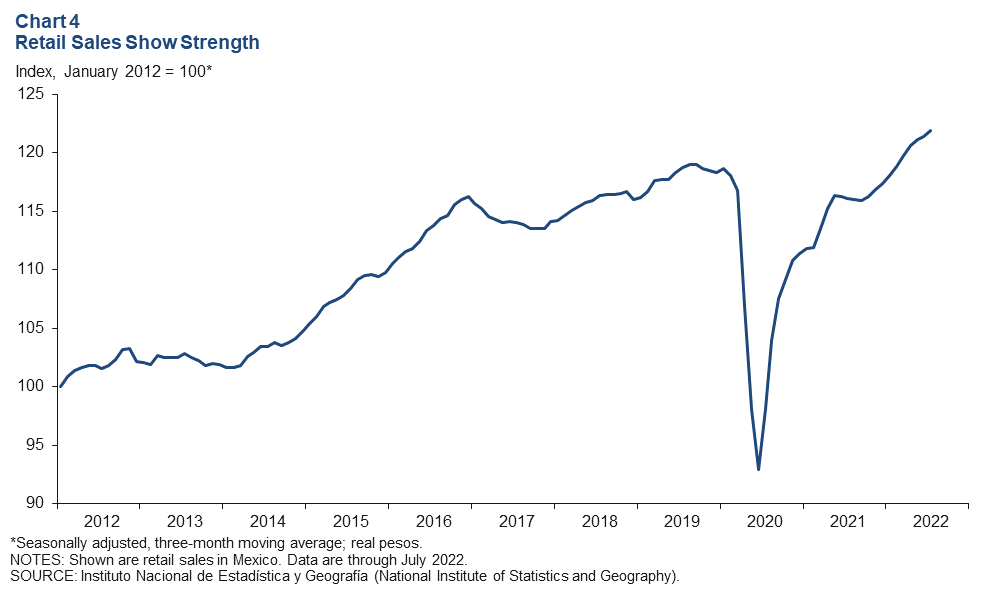
Payroll growth picks up
Formal sector employment—jobs with government benefits and pensions—grew an annualized 3.8 percent (66,500 jobs) in August after increasing 1.5 percent in July (Chart 5). Year-over-year employment growth was 8.5 percent in August. Total employment, representing 57.4 million workers and including informal sector jobs, was up 3.9 percent year over year in June. The unemployment rate in July was 3.2 percent, down from 3.3 percent in June. Employment in Mexico recovered to prepandemic levels in September 2021, while GDP just reached prepandemic levels in second quarter 2022.
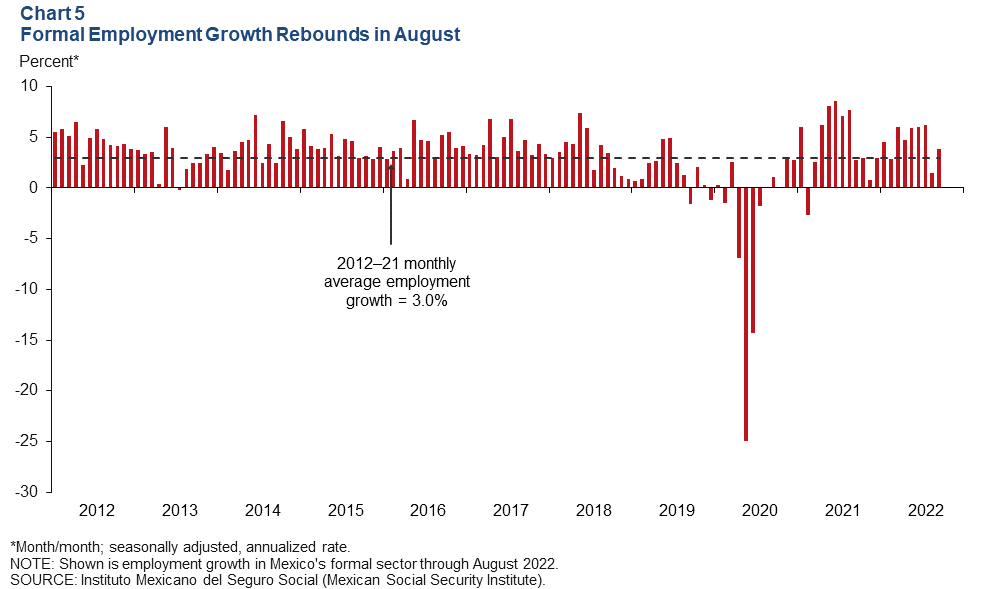
Peso gains slightly against the dollar
The Mexican currency averaged 20.1 pesos per dollar in September, on par with the August level but up from 20.5 in July (Chart 6). However, the peso is still down 6.3 percent from its prepandemic level in February 2020. The peso has been under pressure due to high inflation and increased uncertainty regarding domestic and global growth.
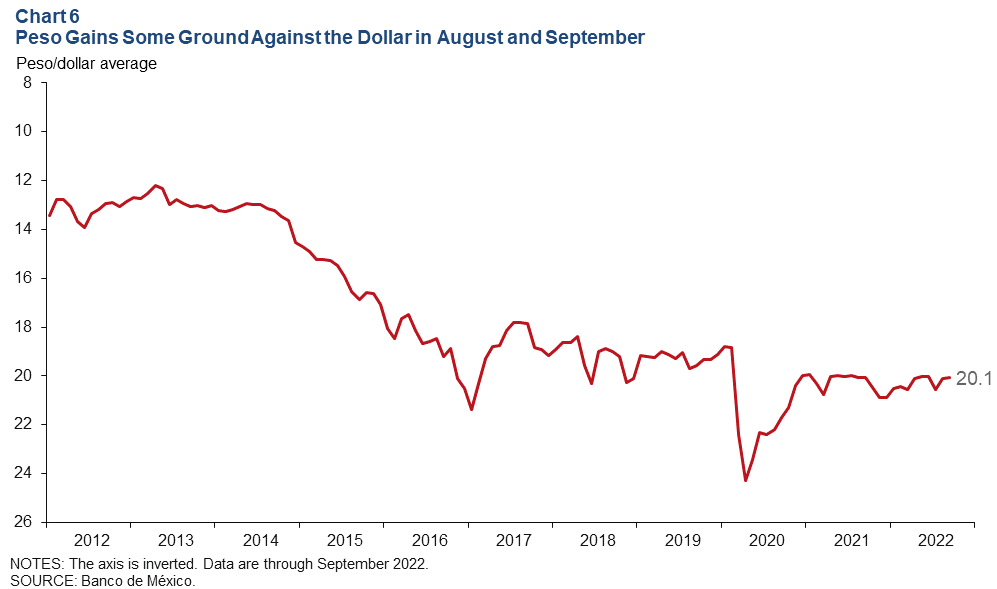
Remittances to Mexico rise
The three-month moving average of real remittances to Mexico increased 1.2 percent in July after rising 1.5 percent in June (Chart 7). On a month-over-month and unsmoothed basis, remittances increased 2.8 percent in July. Most likely, remittance flows to Mexico slowed at the beginning of 2022 due to high inflation in the U.S. and elsewhere, which erodes disposable income, including funds for remittances. However, remittances to Mexico bounced back in May and have grown for three consecutive months.
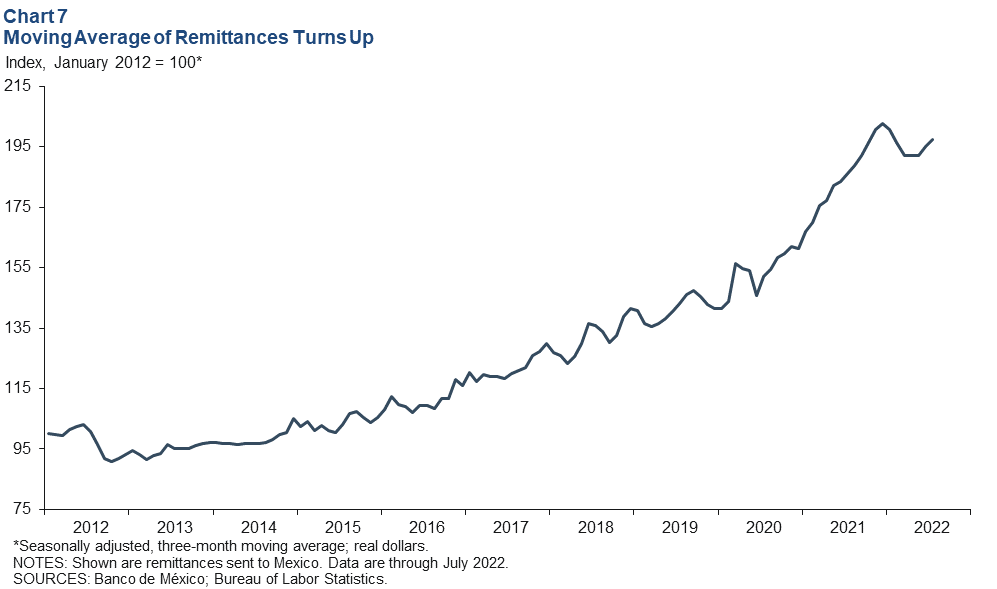
Foreign-owned government debt share continues to fall
The three-month moving average of foreign‐owned Mexican government securities decreased to 16.8 percent in July, down 0.4 percentage points from its June value (Chart 8). The decline is due to a reduction in foreigners’ ownership of long-term securities. The extent of nonresident holdings of government debt is an indicator of Mexico’s exposure to international investors and a sign of confidence in the Mexican economy. It’s noteworthy that the measure has been on a downward trend since peaking in early 2015. Long-term government securities make up 83 percent of foreign‐owned Mexican public debt.
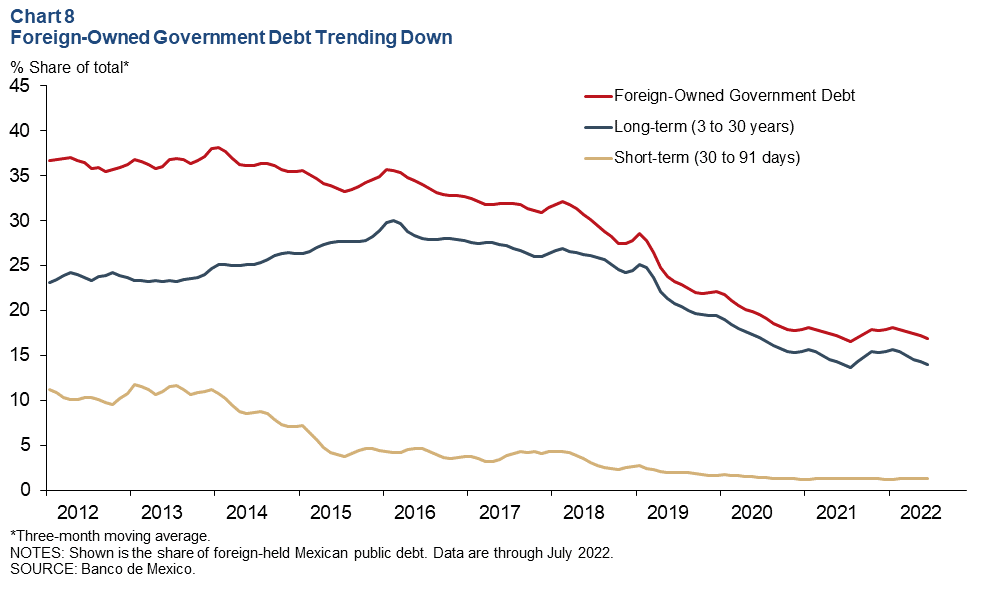
August iInflation remains elevated
Mexico’s consumer price index (CPI) was up 8.7 percent in August over the prior 12 months, rising from July’s 8.1 percent gain (Chart 9). CPI core inflation (excluding food and energy) rose 8.0 percent in August over the previous 12 months. In September, Mexico’s central bank increased the benchmark interest rate by 75 basis points to 9.25 percent. In the public announcement accompanying the interest rate decision, the central bank cited ongoing tightening of global financial conditions and increasing uncertainty in outlooks as reasons for the increase.
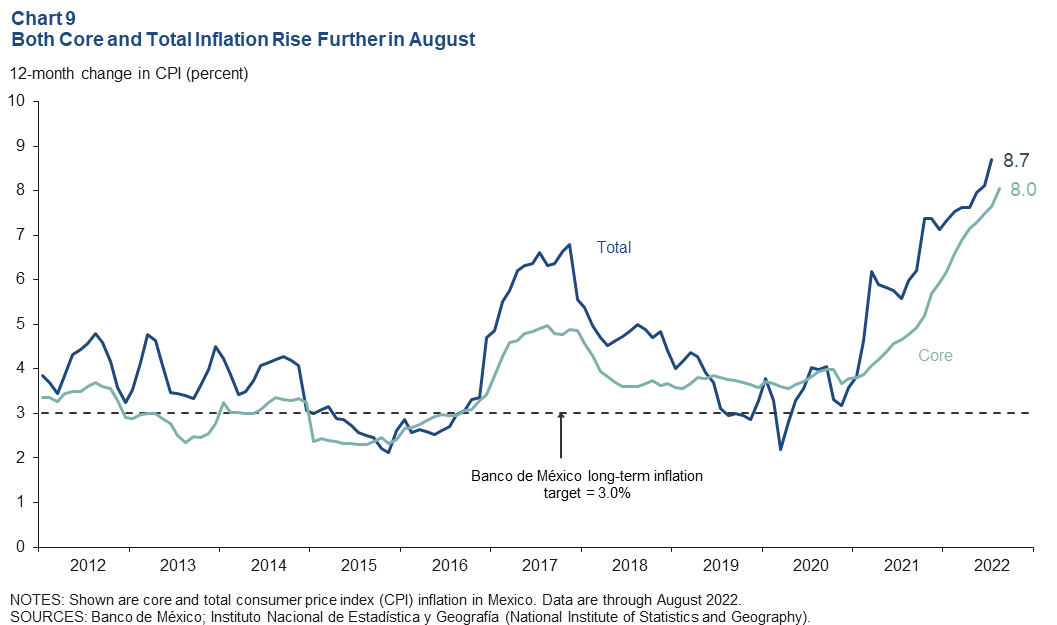
About the Authors
The views expressed are those of the authors and should not be attributed to the Federal Reserve Bank of Dallas or the Federal Reserve System.

